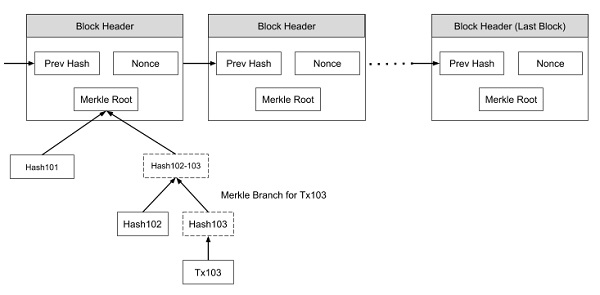
- Blockchain - Home
- Blockchain - Introduction
- History of Blockchain
- Blockchain - Technology
- Blockchain and Cryptography
- Blockchain Beyond Crypto
- Blockchain - Advanced Concepts
- Blockchain - Decentralization
- Blockchain - D-Apps
- Blockchain - DeFi
- Blockchain - Future Scope
- Smart Contracts in Blockchain
- Blockchain - Ricardian Contracts
- Blockchain - Oracles
- Blockchain - DAO
- Bitcoin
- Bitcoin - Invisible Gold
- How Bitcoin Works?
- Bitcoin - Network
- Bitcoin - Wallets
- Bitcoin - Innovations
- Ethereum
- Ethereum Alternate Cryptocurrency
- Ethereum Ecosystem
- Ethereum Virtual Machine
- Advanced Ethereum
- Ethereum Wallets
- Ethereum Miner Nodes
- Miscellaneous
- Blockchain - Double Spending
- Public Key Cryptography
- Blockchain - Hashing
- Bitcoin - Mining
- Blockchain - Chaining Blocks
- Blockchain - Proof of Work
- Blockchain - Network & Mining
- Blockchain - Incentives to Miners
- Blockchain - Merkle Tree
- Blockchain - Payment Verification
- Blockchain - Resolving Conflicts
- Blockchain - Privacy
- Bitcoin - Mitigating Attacks
- Blockchain - Conclusion
Blockchain - Payment Verification
Consider a case whereby as a vendor you may like to verify a certain payment made in the past. As the blockchain you are holding on your machine contains only the block headers as shown in the earlier figure, the transaction that you are searching for is missing in the copy of your blockchain.
You can now search backwards in your copy of the blockchain until you find a block in which the desired transaction is timestamped in. Now, request the merkle tree of the selected block and you will have the transaction that you are looking for. This is illustrated in below Figure −

Here, we assume that you are looking for Tx103. Though you may not be able to see the contents of Tx103, you know that this has been accepted by the block to which it belongs and all subsequent blocks in the chain. Thus, you can safely trust this transaction and proceed with your business.